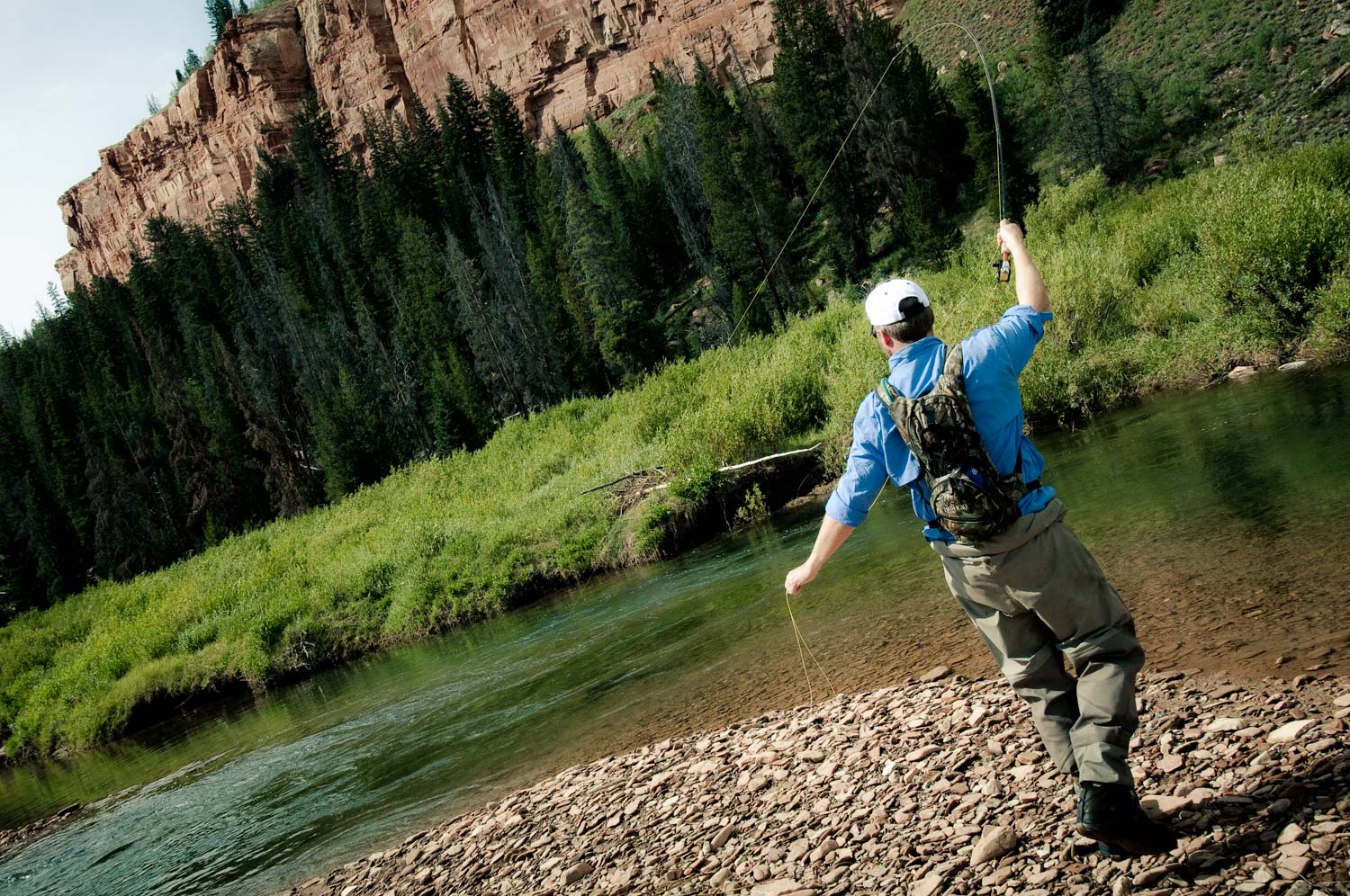
Photos by Louis Cahill
By Jason Tucker
In the public mind there is probably no feature that comes more readily to mind than the Ole Fishin’ Hole.
A lot of non-fishers think that is what fishing is about- going to a big, well-known hole, soaking bait, waiting for the fish to bite. I certainly spent a lot of my childhood believing this was the way to fish.
Especially once you get into fly fishing, you realize those big holes don’t hold all the fish, and probably are some of the least interesting places for the fly angler. After all, fish on the bottom of that big hole aren’t likely to rise eight feet through the water to hit your fly. Learning to identify fish holding water and cover on a small stream is just as important as your casting and fly selection. It is especially important because you need to identify these spots from a distance, pick out the likely fish holding lies, so that you can stealthily approach the spot and present your fly. I can’t tell you the number of times I have (and still do) failed to properly identify fish holding structure and blundered into a spot that was a great opportunity just waiting for my fly.
Holes. After demeaning them at the outset, it is time to redeem them. Holes hold fish, lots of fish, but it’s not enough to approach one and start flogging.
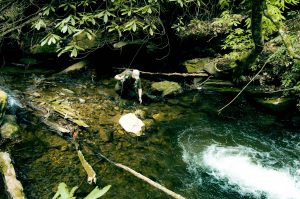 The problem with holes is that a true hole will be too deep to fish a dry fly unless you see fish lingering near the surface feeding. This does happen, and if you run into that situation, by all means move into position and start casting. More often you will find yourself happening on a hole with no perceptible action and will need a game plan. There are four areas to concentrate on when you get to a hole: the tailout, the margins, the head, and the hole itself.
The problem with holes is that a true hole will be too deep to fish a dry fly unless you see fish lingering near the surface feeding. This does happen, and if you run into that situation, by all means move into position and start casting. More often you will find yourself happening on a hole with no perceptible action and will need a game plan. There are four areas to concentrate on when you get to a hole: the tailout, the margins, the head, and the hole itself.
If you’re fishing from downstream, the tailout is what you want to concentrate on first. I spent many a summer day observing big holes in rivers as a child. There was a bridge on a hole that we always fished. The bridge was in the middle of nowhere, not even on a road. I believe that landowner had the bridge repaired at some point, as it was in good shape. It was originally a stagecoach bridge in Michigan’s logging days. It served an old hotel that used to be there. Nostalgia aside, I learned a lot sitting on that bridge soaking worms.
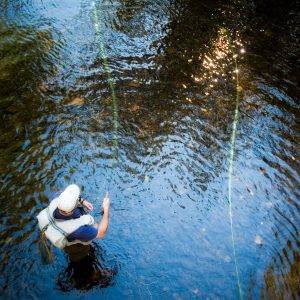 When we would walk out on the bridge it was common to watch thirty or more fish scoot for cover in the deepest part of the hole. The thing to do then was to sit still and wait for the fish to relax and return to their feeding lies. After ten minutes small fish would start to move back out into feeding positions. After twenty minutes they would start to feed again. After thirty minutes even the larger fish would become visible if they were going to feed. A lot of the prime lies were near the bank on the deep side, and also at the head of the hole, but a lot of fish would drift back to the tailout and wait to feed. So when you are approaching a hole this is where you want your first cast to go. You’ll want your fly to land where the color changes from dark to lighter. The fish here may be sensitive to being cast over, so you don’t want to cast too far into the center of the hole and line the fish. Make a few casts to the tailout and work the whole area from shallow to deep before moving onto your next target.
When we would walk out on the bridge it was common to watch thirty or more fish scoot for cover in the deepest part of the hole. The thing to do then was to sit still and wait for the fish to relax and return to their feeding lies. After ten minutes small fish would start to move back out into feeding positions. After twenty minutes they would start to feed again. After thirty minutes even the larger fish would become visible if they were going to feed. A lot of the prime lies were near the bank on the deep side, and also at the head of the hole, but a lot of fish would drift back to the tailout and wait to feed. So when you are approaching a hole this is where you want your first cast to go. You’ll want your fly to land where the color changes from dark to lighter. The fish here may be sensitive to being cast over, so you don’t want to cast too far into the center of the hole and line the fish. Make a few casts to the tailout and work the whole area from shallow to deep before moving onto your next target.
The next target is the margins of the hole. Typically at least one side of the hole has a gradual slope to the bank. Fish that want to feed will often move out of the hole into water on that margin that is two to four feet deep in order to be within reach of the surface. That margin is often the most overlooked part of a hole, and one of the most productive. It can be one of your best chances at catching a big fish. Fish in the margin also tend to be less line shy. You are targeting the color change from clear, shallow water near the bank, to the darker water as it deepens toward the hole. Often fish will be holding right on the border between the clear and the colored water.
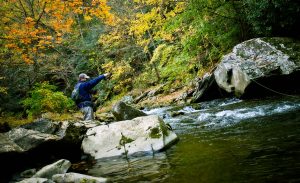 The border between the clear and colored water also often denotes a current break, with the faster current being in the dark water, and the clear shallow water running slow to still. You can usually get a good consistent drift down that darker water right next to the clear. If this doesn’t work, an often deadly tactic is to cast to the clear water right next to the dark. You will need to make sure your entire line is in that slower water, and that your fly is drifting right on the border of the faster darker water. Often a fish holding in that deeper water cant resist sliding out to grab a fly that is lingering right next to the deeper water. This is great water for nymphing as well.
The border between the clear and colored water also often denotes a current break, with the faster current being in the dark water, and the clear shallow water running slow to still. You can usually get a good consistent drift down that darker water right next to the clear. If this doesn’t work, an often deadly tactic is to cast to the clear water right next to the dark. You will need to make sure your entire line is in that slower water, and that your fly is drifting right on the border of the faster darker water. Often a fish holding in that deeper water cant resist sliding out to grab a fly that is lingering right next to the deeper water. This is great water for nymphing as well.
Head of the hole. Perhaps the most obvious spot to fish is where the current dumps into the hole. Fish that want the first crack at food floating downstream will be positioned here at the drop-off. If the hole is big enough there may be several good lies to hit. On a small stream it may just be one. Some holes on small streams are small enough that you may be better off skipping the other areas and casting straight to the head of the hole if you think that is where the best fish will be. Some holes will be small enough that no matter where the fly hits a fish will move to take it. With experience you’ll figure out whether you need to break a hole into its constituent parts or treat it as a single lie. Rising fish will always be your best indicator of where to cast.
The hole itself. I’ll here define the hole as the deepest part of the hole, if that makes any sense. It is deep, dark water that is normally too deep to fish with a dry fly to fish resting on the bottom. Fish on the bottom of a hole are typically not interested in feeding on the surface. They will be resting, hiding, or feeding on nymphs drifting by. There won’t be much you can do to interest them in the surface. If you can get a nymph down deep and get a good drift, you have a shot.
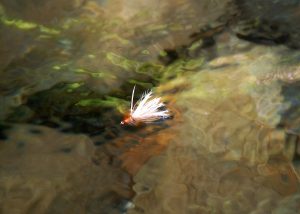
Louis Cahill Photography
There are exceptions to this, such as when fish suspend to feed on emerging insects. A lot of fish will move to the other areas to feed, but some will suspend in the hole if the current is delivering food. I will always keep an eye out for fish feeding on the hole itself while not concentrating on it. If there is a strainer or brush on the surface, look for fish feeding on the leading edge of it where current concentrates drifting flies.
Another exception to this is that holes tend to be relative to the size of the stream you are fishing, and we are discussing small streams. On a small enough stream a hole may be the size of a bathtub and be the very best spot to place a fly. They may be the only places that hold fish. Adjust your mindset to the stream you are fishing, and above all let the fish and the stream tell you how to fish it.
 Runs. If I could construct a stream made entirely of outside bends and runs I would. Michigan’s Manistee river is near perfect, but it’s a big river so I won’t discuss it further. A run is a straight stretch of river with water deep enough to hold fish. If it has a stony bottom that produces a chop on the surface, so much the better. As a matter of fact, that surface chop is a better indicator of fish holding water than depth is. You are looking for water that is just slightly too deep to see the bottom. A lot of runs are set up like stretched out holes, with deeper water at the top with a long taper to the tail-out. A good run will be consistently deep, have that chop, and hold fish from top to bottom. Fish in a run will be looking to feed and within reach of the surface. I break runs into cast-lengths. Don’t make the mistake of moving each cast up two to three feet at a time as the fly landing just behind a fish is a good way to spook it. Cast to a length of the run, then quietly move up to where you just presented the fly and repeat until you’ve reached the top. Often the tail of a run will be as good as or better than the head.
Runs. If I could construct a stream made entirely of outside bends and runs I would. Michigan’s Manistee river is near perfect, but it’s a big river so I won’t discuss it further. A run is a straight stretch of river with water deep enough to hold fish. If it has a stony bottom that produces a chop on the surface, so much the better. As a matter of fact, that surface chop is a better indicator of fish holding water than depth is. You are looking for water that is just slightly too deep to see the bottom. A lot of runs are set up like stretched out holes, with deeper water at the top with a long taper to the tail-out. A good run will be consistently deep, have that chop, and hold fish from top to bottom. Fish in a run will be looking to feed and within reach of the surface. I break runs into cast-lengths. Don’t make the mistake of moving each cast up two to three feet at a time as the fly landing just behind a fish is a good way to spook it. Cast to a length of the run, then quietly move up to where you just presented the fly and repeat until you’ve reached the top. Often the tail of a run will be as good as or better than the head.
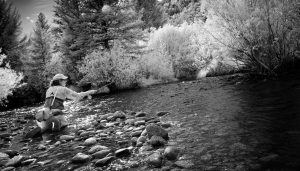 Outside bends. Outside bends are another personal favorite on a small stream. They often provide sufficient depth to hold fish, consistent current for a good drift, often coupled with an undercut bank the fish love for cover. The fish will be hard up against that bank. Don’t ignore the inside margin; active fish will often slide to the shallow side to feed, so keep an eye out there. Fish from the inside out. Like a run, you’ll want to dice up an outside bend into cast lengths, trying not to disturb the fish in the next cast zone upstream. If you catch a fish in the bottom drift, move up to almost where you caught that fish (provided no other fish are feeding there) and hit the next drift. There will always be a line where the current is flowing next to slack water right on the bank. Your best drift will be as close to that slack water and the bank as possible. It may even be possible to reach cast and let your fly hang out in that slack water, or accomplish it with an upstream mend. Sometimes that fly just hanging there is all it takes to make a fish go for it.
Outside bends. Outside bends are another personal favorite on a small stream. They often provide sufficient depth to hold fish, consistent current for a good drift, often coupled with an undercut bank the fish love for cover. The fish will be hard up against that bank. Don’t ignore the inside margin; active fish will often slide to the shallow side to feed, so keep an eye out there. Fish from the inside out. Like a run, you’ll want to dice up an outside bend into cast lengths, trying not to disturb the fish in the next cast zone upstream. If you catch a fish in the bottom drift, move up to almost where you caught that fish (provided no other fish are feeding there) and hit the next drift. There will always be a line where the current is flowing next to slack water right on the bank. Your best drift will be as close to that slack water and the bank as possible. It may even be possible to reach cast and let your fly hang out in that slack water, or accomplish it with an upstream mend. Sometimes that fly just hanging there is all it takes to make a fish go for it.
Jason writes the fine blog Fontinalis Rising
Jason Tucker
Gink & Gasoline www.ginkandgasoline.com hookups@ginkandgasoline.com Sign Up For Our Weekly Newsletter!
Jason, very useful information. Never hurts to read about this basic stuff. Thanks
Pingback: Small Stream Structure | MidCurrent